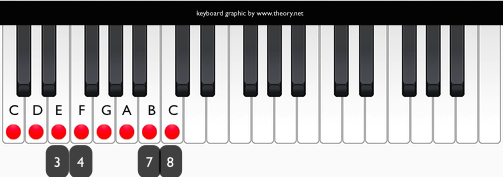Welcome to Flat Key Signature
Music Theory Sixth Floor
Before we dive into constructing Flat Key signature let's recap a bit on the sharp thing...
Ok, so hopefully you’ve "clicked" that key signature itself is arrived at when creating a major scale. Right now you can do any major scale starting on any white (natural♮) piano key (except for F♮). Remember “the” major scale is any scale that has 1/2 steps at scale tones 3 to 4 and at 7 to 8.
From another perspective you are just recreating the pattern of ♮1/2 steps that occur in C major from different starting notes other than C.

The only difference is you need to add accidentals (♯’s or ♭’s) to make that happen. So far we have only used ♯’s (sharps) to make that happen.
You can now start on any ♮note and create “the” Major (Ionian) Scale. Any ♮note that is, except for F♮. Why is that?
The Reason F is Different
The only reason F♮is different is because of the alphabet. ...Well sort of... We treat it differently because we want the alphabet that we are so familiar with to remain intact. Let me show you.
The Flat Key Signature of F Major

Let’s do our non-notational written exercise from the Music Theory Fifth Floor Page this time on F♮.
First we write the letters from F♮ to F♮ and number them 1-8.
F1 G2 A3 B4 C5 D6 E7 F8
Then we mark where the half steps need to be to make this run of notes sound like the major scale.
F1 G2 A3/B4 C5 D6 E7/F8
Then we check is F1 to G2 a whole step? Yes.
G2 to A3? Yes.
A3 to B4? Yes. Do we want a whole step there? NO!
The major Scale is any scale that has
1/2 steps at 3 to 4 and at 7 to 8

What do we do? Make the A sharp (♯) you may say. Well that does indeed make a half step at 3 to 4 BUT…
It also makes scale tones G2 to A♯3 one and a half steps apart. It also doesn’t solve the other problem of scale tones B4 to C5 being half steps apart. Remember B to C is one of our ♮1/2 steps. This won’t sound like a major scale. It will also mess up our alphabetical system by putting two A notes in the same scale! So what do we do? We start the cycle of Flat Key Signature. Here’s how.
In order to get our half steps to fall at 3 to 4 and at 7 to 8 like we want them to (keeping the alphabet intact) we need to leave the poor A note alone and pick on the note B.
What we do is we lower the B note by 1/2 step to B♭ (B flat).
That gives us:
F to G whole step -1 to 2
G to A whole step – 2 to 3
A to B♭ half step 3 to 4 (scale tones 3 and 4)
B♭ to C whole step - 4 to 5
C to D whole step – 5 to 6
D to E whole step – 6 to 7
…and finally
E to F half step 7 to 8 (one of the ♮1/2 steps also now scale tones 7 to 8)
Here is that snap shot again just to remind you

What Happens Next?
If you get the idea of what is happening here you can see what is going to happen. We need to be able to play and understand the other flat keys that exist. They follow the cycle of fourths (FBEADGCF)
-the same way our sharp keys follow the cycle of fifths (FCGDAEB).
Time to move on to Music Theory Sixth Floor Page Two
If you want another perspective have a look at this lesson provided by http://www.musictheory.net/lessons/24
Many thanks to Ricci Adams at www.musictheory.net
Home>Top>Music Theory Fifth Floor>Go to Music Theory Sixth Floor Page TWO>click here to support this site
If you are local to the United Kingdom West Midlands Coventry Kenilworth Leamington Warwick Rugby Stoneleigh CV8 Post Code area and are interested in tuition feel free to arrange a “First session Free” Guitar or Theory Lesson. Perhaps you just want to *chat over a cuppa about the options for your children’s music education.
Playable Guitar
Rural Innovation Centre Unit 32 Avenue H
Stonleigh Park CV8 2LG +44 2476 998 500
International? Please contact me about Skype lessons. Se habla español – pues bueno un pocito!
click here to see other ways to support this site
Got suggestions or questions?
Want to try a free Skype or Zoom lesson?
Got a testimonial? click here
Click the link to the contact form above or write to me at the address shown and I will get back to you as quick as I can !
Happy playing!


